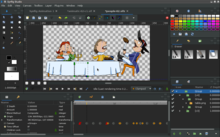Synfig
 | |
 | |
| Original author(s) | Robert Quattlebaum |
|---|---|
| Stable release | 1.4.4[1]
/ December 28, 2022 |
| Preview release | 1.5.1[2]
/ October 30, 2021 |
| Repository | |
| Written in | Mac OS X, Windows |
| Type | Vector graphics editor, computer animation |
| License | GPL-2.0-or-later |
| Website | synfig |
Synfig Studio (also known as Synfig) is a free and open-source vector-based 2D animation software.[3] It is created by Robert Quattlebaum[4] with additional contributions by Adrian Bentley.
Synfig began as the custom animation platform for Voria Studios (now defunct),[5] and in 2005 was released as free/open source software, under GNU GPL-2.0-or-later.[6]
Features
As a true
The goal of the developers is to create a program that is capable of producing "feature-film quality animation with fewer people and resources."
The software is capable of simulating soft-shading using curved
File formats
Synfig stores its animations in its own XML file format, often compressed with gzip. These files use the filename extension .sif (uncompressed), .sifz (compressed) or .sfg (zip container format). The files store vector graphics data, embed or reference external bitmap images, and also a revision history of the project.
Synfig can render to video formats such as
From version 0.62.00, Synfig has basic support for
From version 0.91 Inkscape can save as .sif file format.
Morevna era

Much of the development of the tool since May 2008 has been in association with the Morevna Project, a
Name
It was originally called SINFG, a recursive acronym for "SINFG Is Not a Fractal Generator", referring to the software's capability of generating fractal imagery in addition to animation.[12]
See also
References
- ^ "Synfig Studio 1.4.4 released – Synfig". synfig.org. December 28, 2022. Retrieved January 2, 2023.
- ^ "Synfig Studio 1.5.1 released – Synfig". synfig.org. October 30, 2021. Retrieved November 1, 2021.
- ^ "Overview - Synfig Animation Studio". wiki.synfig.org. Retrieved 2020-09-18.
- ^ "Interview with Synfig's Robert Quattlebaum".
- ^ "Voria Studios Closing Letter". Archived from the original on 2011-03-24.
- ^ "Synfig Open-Source Announcement". 19 November 2018.
- ^ "Synfig Studio :: Home".
- ^ Bowen, Ronda (13 March 2011). "Top 5 Low-Budget and Free Flash Editors". Brighthub.com. Bright Hub Inc. Retrieved 7 February 2015.
- ^ "Synfig 0.62.00 Release". Archived from the original on 2010-05-25.
- ^ "Morevnaproject.org".
- ^ "The Morevna Project: Anime with Synfig and Blender". Archived from the original on 2011-08-14.
- ^ "Synfig Studio :: History".
